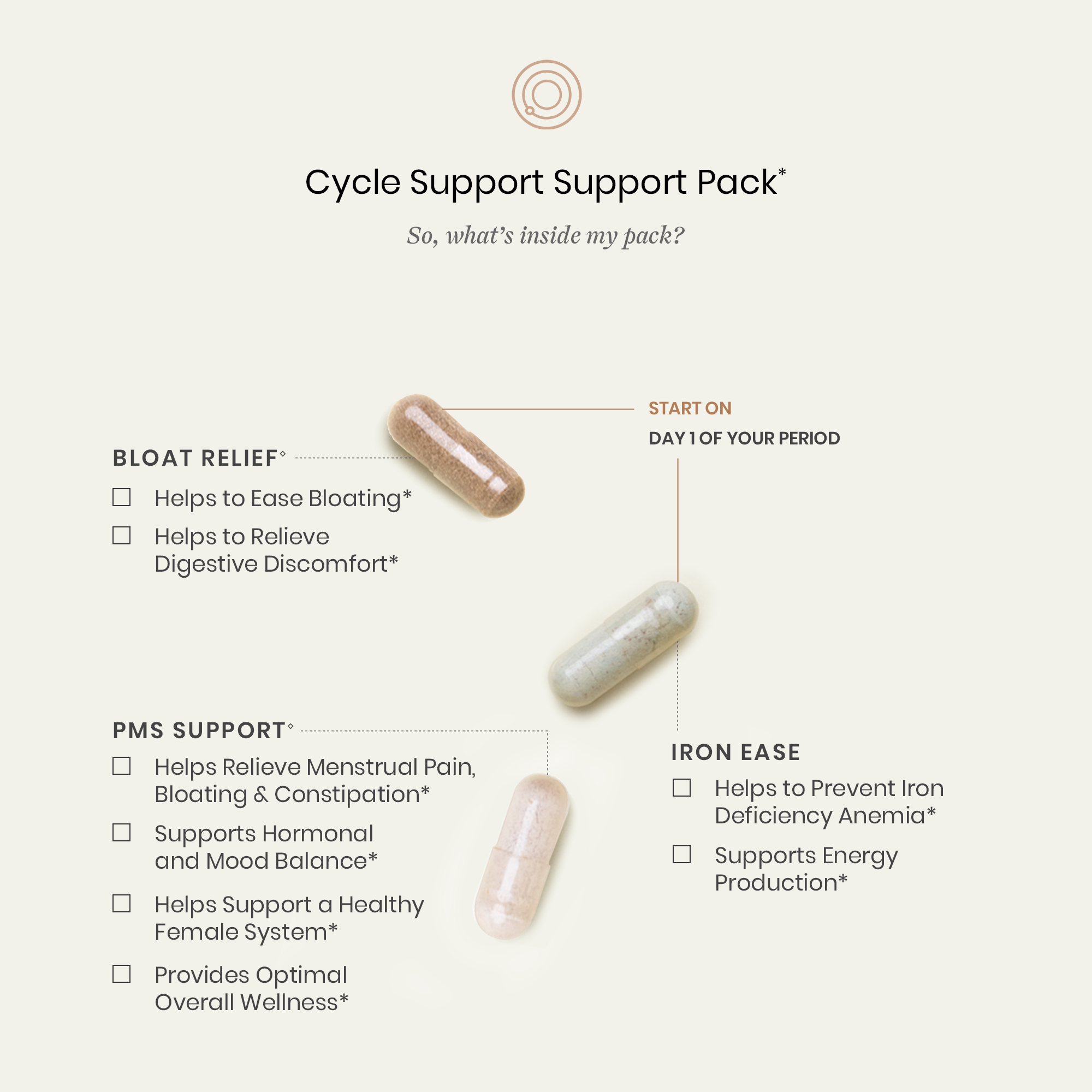The beauty (and pain) of the female body is that it’s always changing. Hormones rise and fall like the tide—sometimes with crashing fervor, other times with a whisper retreat—but always cyclically.
The complexity and rhythm of our bodies is impressive—unfortunately, though, we also know that some phases of our cycle are more enjoyable than others. Whether you’re riding the energetic high of ovulation, or slithering through the sluggish low of PMS, there are ways to support your body through your cycle with thoughtful movement and intentional nourishment. To guide us with expert suggestions, we tapped into the wisdom of Dr. Caitlyn, O’Connor, a Naturopathic Doctor who specializes in holistic treatment for women. Read on for her suggestions on how to best honor the phases of your cycle.
Shop the Article:
Menstruation
Nourishment: When the body sheds its uterine lining during menstruation, it’s important to “focus on iron-rich foods” that can help replace any iron depletion happening during your period. Consider incorporating iron superstars like spinach, red meat, broccoli, legumes, pumpkin seeds, quinoa, tofu, and dark chocolate—and our Cycle Support Pack, which contains a gentle iron supplement to support your levels during this time.
Movement: “Typically what we think about is during your menstrual flow, especially if people are having heavier flows and they’re not feeling energized, that is generally a time where people might want to rest, take some days off from exercise, or do more mild to moderate exercise,” Dr. O’Connor suggests.
Follicular and Ovulation
Nourishment: During the follicular phase, your body is more efficient at burning fat due to increased insulin sensitivity. What does that mean exactly? Slow-absorption carbs are more likely to be processed quickly for energy instead of stored for fat.1 This makes the days leading up to ovulation—and ovulation itself—a great time to reach for slow-absorption carbs like brown rice, legumes, lentils, and fiber-rich fruit. If you have any lingering breast sensitivity or mood swings after menstruation, you can also consider adding in phytoestrogen-rich foods like soybeans, flax seeds, and chickpeas which can help balance estrogen levels.1
Movement: "Typically, during the follicular phase leading up to ovulation is when people are most energetic, so for some folks that’s a time where if they’re trying to really push their workouts, that could be a time to focus on their more hardcore exercises,” Dr. O’Connor suggests. Going for a personal fitness record? Hit it during your follicular phase or ovulation. But keep in mind, “I think it should always be based on how the person feels. Listen to your body,” Dr. O’Connor says.
Luteal
Nourishment: “During the luteal phase, the phase between ovulation and menstruation, people do have an increased metabolic need to build a uterine lining,” Dr. O’Connor explains. “So, folks are naturally hungrier during this phase. I think a lot of why people have more sugar cravings during the second half of their cycle is because their body is trying to signal to them that they need to increase their caloric intake to fuel the building of the uterine lining which is a pretty dense piece of material.”
“Oftentimes people need to eat a little bit more during their luteal phase, and eat more protein and complex carbohydrates, which will often reduce sugar cravings. When the body has gotten the message ‘oh we’ve gotten enough food,’ it’s not sending out that sugar signal,” Dr. O’Connor advises.
Movement: “Some folks with PMS do get more fatigued and irritable and they don’t necessarily feel like moving as much, but any sort of physical activity is going to be helpful to modulate mood and bloating. Typically I will say try to find something that seems like a tolerable form of movement, and try to be consistent with that throughout the luteal phase,” Dr. O’Connor suggests. Another reason to keep moving during this phase? “There is good data to support that exercise in general can result in less heavy menstrual periods and less heavy cramping.”2
Looking to balance symptoms like fatigue, bloating, and mood swings? Meet Cycle Support, our game-changing new vitamin pack that syncs with your cycle—promoting hormonal balance and targeted symptom relief through every phase.
Resources:
- Domínguez-López I, Yago-Aragón M, Salas-Huetos A, Tresserra-Rimbau A, Hurtado-Barroso S. Effects of Dietary Phytoestrogens on Hormones throughout a Human Lifespan: A Review. Nutrients. 2020 Aug 15;12(8):2456. doi: 10.3390/nu12082456. PMID: 32824177; PMCID: PMC7468963.
- Hightower M. Effects of exercise participation on menstrual pain and symptoms. Women Health. 1997;26(4):15-27. doi: 10.1300/j013v26n04_02. PMID: 9525266.
Written by Jessica Lopez. Jessica Lopez is a freelance writer, digital content creator, and new mother. She has covered all lifestyle topics ranging from bridal to beauty for publications including Brides Magazine, Byrdie, THE/THIRTY, and more. Walking wide-eyed into motherhood has inspired her to connect with other parents through her writing and shared experience. You can follow more of her journey@Jessica.H.Lopez.



